Manners, Customs, Clothing
 |
 |
 |
 |
 |
 |
 |
The History of the Tie - I
Fashion, the Necktie and the Revolution
After writing a brief item on the tie for the Do’s and Don’ts section of our website, I was asked to develop the topic and write several short articles detailing the history and symbolism of the necktie. Here is the first article of the series.
A devolution in men's clothing
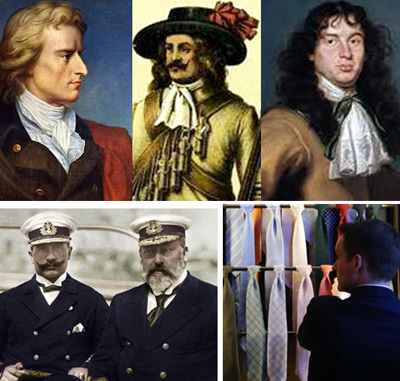 Along the centuries, clothing has served a dual purpose. It is used not only as a protection from the elements and concupiscence, but also as a vehicle for expression. For example, in the past it was customary to know a person’s exact profession simply by his clothing. This idea – to express one's state in life through his outward appearance – was born out of the natural social hierarchy and good customs so deeply rooted in Christendom.
Along the centuries, clothing has served a dual purpose. It is used not only as a protection from the elements and concupiscence, but also as a vehicle for expression. For example, in the past it was customary to know a person’s exact profession simply by his clothing. This idea – to express one's state in life through his outward appearance – was born out of the natural social hierarchy and good customs so deeply rooted in Christendom.
However, from the French Revolution onward, we see a gradual but deliberate degradation in good customs, particularly with regard to fashion. We can note a hierarchical devolution in clothing, with man opting for egalitarianism and vulgarity rather than dignity and nobleness. The necktie was one article of clothing that was not spared in this fashion revolution. I hope to show the reader this gradual devolution by presenting a closer look at the tie’s origins and its uses in society, particularly in the West.
An unexpected discovery
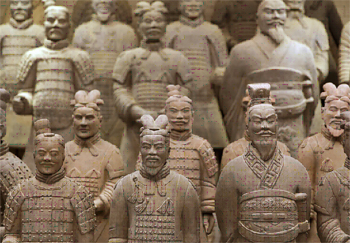 A 1974 excavation in Xian, China, revealed thousands of terracotta soldiers in the tomb of Chinese Emperor Qin Shih Huang, dating back to 210 BC. Created to accompany the Emperor in what they believed to be the afterlife, these clay men exhibit a serious and dignified physiognomy.
A 1974 excavation in Xian, China, revealed thousands of terracotta soldiers in the tomb of Chinese Emperor Qin Shih Huang, dating back to 210 BC. Created to accompany the Emperor in what they believed to be the afterlife, these clay men exhibit a serious and dignified physiognomy.
Adding to this dignity is their neckwear: The soldiers are wearing pieces of neck cloths of differing styles and sizes, all revealing a sense of distinction and honor. Though decorative in nature, these neck pieces seem to contribute to a sense of valor while preserving military masculinity.
For the next documented use of the necktie, we move west to the Roman Empire.
Dignified Roman soldiers
We can see how the Romans used neckwear by observing the famous monument to the Emperor Trajan (aptly called Trajan’s Column), located in Rome and dating back to 97-117 AD (pictured below).
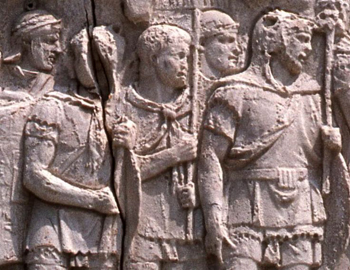 The cloths around the necks of the soldiers accentuate their imposing posture and communicate a dignity and honor inherent in their military vocation. By carefully examining their expressions, it is clear that these men are prepared to give their lives for the cause of the Roman Empire, and their neckwear seems to contribute to this feeling of heroism.
The cloths around the necks of the soldiers accentuate their imposing posture and communicate a dignity and honor inherent in their military vocation. By carefully examining their expressions, it is clear that these men are prepared to give their lives for the cause of the Roman Empire, and their neckwear seems to contribute to this feeling of heroism.
These cloths were not only used for decorative and honorific purposes, but also for protection. According to some accounts, Roman orators would tie a cloth around their neck called the focalium. This would protect the neck and throat from the cold, which was extremely important for the orators, who relied on their throat to perform their role. When they didn’t have a focalium handy, they would instead use a handkerchief for the same purpose, which they called the sudarium.
Gradually, wearing a cloth around one’s neck became a fashion staple in the West. It evolved into the ruff, a type of circle collar that became popular especially among nobles in the 1500’s. These cloths were avant-couriers [precursors] of the modern necktie and paved the way for the next phase in neck cloths, which was the cravate. This new phase occurred during the Thirty Years War of Central Europe (1618-1648).
Croats and the Cravate
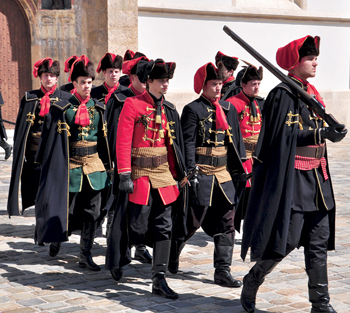 During that war, Croatian mercenaries were employed by the French to fight alongside their own soldiers. These Croatian fighters were not only well-known for their military prowess, but also for the distinct and colorful cloths they wore around their necks. These cloths were attractive to the French soldiers, who were used to wearing stiff collars for their uniforms.
During that war, Croatian mercenaries were employed by the French to fight alongside their own soldiers. These Croatian fighters were not only well-known for their military prowess, but also for the distinct and colorful cloths they wore around their necks. These cloths were attractive to the French soldiers, who were used to wearing stiff collars for their uniforms.
After some time, King Louis XIV assumed the throne in 1643, and quickly became known for his flair for fashion. He took a particularly liking to these Croatian neck cloths, so much so that he began to wear them himself and even employed the services of a cravatier: This necktie-maker would present the “Sun King” daily with an assortment of ties, or cravates, that he would pick from, depending on the outfit he would decide to wear that day.
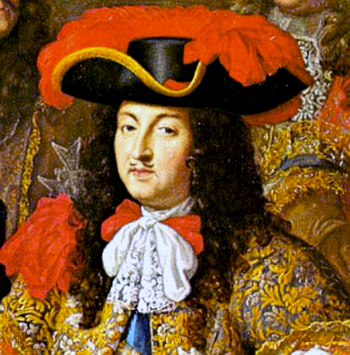 Soon after King Louis XIV’s adoption of this neck cloth, the military and courtiers began to wear them. This Croatian neck cloth came to be known in France as the cravate. The cravate not only became a mark of distinction, but according to H. LeBlanc (author of The Art of Tying the Cravat), it also served as a “letter of introduction.”
Soon after King Louis XIV’s adoption of this neck cloth, the military and courtiers began to wear them. This Croatian neck cloth came to be known in France as the cravate. The cravate not only became a mark of distinction, but according to H. LeBlanc (author of The Art of Tying the Cravat), it also served as a “letter of introduction.”
Interestingly enough, the French word cravate is a derivative of hrvati, the Croatian word for “Croatians.” This Croatian derivation for the word “tie” has stood the test of time, making itself present in our modern day in over 30 languages.
From France, the cravate then travelled to England. When King Charles II resumed the throne in 1660, he brought with him all the latest fashions from France. One of these fashions was the cravate, which soon became synonymous with the well-dressed English gentleman. During this era, starch was used to stiffen the cravate for a distinct look.
Industrial Revolution
The modern tie as we know it found its form after the Industrial Revolution in the 19th century. It is here that we must pause briefly to make an important note: We can see concretely the effects of the Revolution during this era.
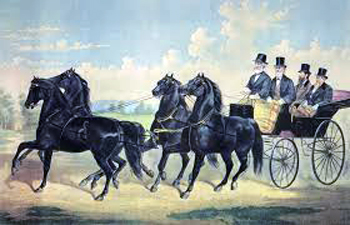 The neck cloth ceased to be a distinct part of dress for an honorable man (regardless of his state in life), but rather the symbol of the egalitarian revolutionary. Colorful and unique clothing ensembles for men had been set aside and replaced with plain dark suits, of which the tie was an essential part. This was a giant egalitarian leap in fashion from previous centuries, and men's' fashion would continue in a steady downward spiral to the modern day.
The neck cloth ceased to be a distinct part of dress for an honorable man (regardless of his state in life), but rather the symbol of the egalitarian revolutionary. Colorful and unique clothing ensembles for men had been set aside and replaced with plain dark suits, of which the tie was an essential part. This was a giant egalitarian leap in fashion from previous centuries, and men's' fashion would continue in a steady downward spiral to the modern day.
Contemporary histories of the tie claim that during this era, workers allegedly sought simplicity and practicality in their dress, wanting to abandon what the Revolution presented to them as the extravagance and excess in clothing of previous years. The necktie, thus, lost its various elaborate forms and instead evolved into a slim, single piece of cloth. Also, until the early 19th century, neckties were white, but by 1829, black silk cravates were standard neckwear for Englishmen.
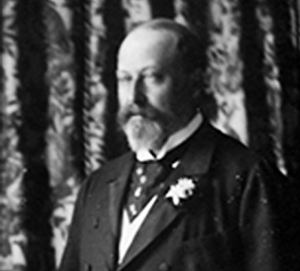 The four-in-hand knot was invented during this time, which ties.com calls the “reigning champion of necktie knots.” The knot was named after the “Four-in-Hand-Club,” an elite group of carriage drivers in London who were known for their four-horse carriages. The members of this group were considered distinguished gentleman who initially wore short distinct neckties along with tidy suits during their carriage rides.
The four-in-hand knot was invented during this time, which ties.com calls the “reigning champion of necktie knots.” The knot was named after the “Four-in-Hand-Club,” an elite group of carriage drivers in London who were known for their four-horse carriages. The members of this group were considered distinguished gentleman who initially wore short distinct neckties along with tidy suits during their carriage rides.
Then, in the 1880s came the Ascot tie, becoming the go-to accessory for men’s daily wear. Much like previous trends, this trend was also popularized by royalty; King Edward VII of England, to be exact. The King wore this large silk cravat when attending horse races. The Ascot tie, then, became the standard for men’s neckwear until the 1920s.
Langsdorf & the necktie
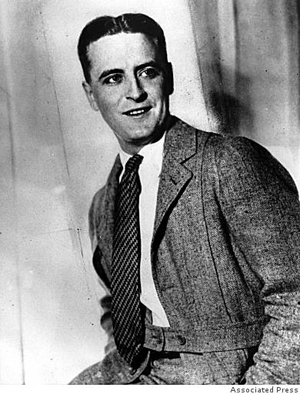 In 1924, New York tie maker Jesse Langsdorf spearheaded an innovation in tie-making: he cut the tie fabric at a 45-degree angle, which allowed it to hang evenly without twisting. This gave us the modern look that we are familiar with now.
In 1924, New York tie maker Jesse Langsdorf spearheaded an innovation in tie-making: he cut the tie fabric at a 45-degree angle, which allowed it to hang evenly without twisting. This gave us the modern look that we are familiar with now.
The necktie today
Sadly, the tie that we all know and love today is in fact a revolutionary construction. What are we to do? Does this mean we have to return to medieval fashions?
Of course not – men mustn’t be scrupulous (or nutty, for that matter). Yes, they must dress with dignity, but in accord with the time and place they live, and according to their state in life. So, should men wear a tie daily? Ideally, yes, especially for public situations.
Continued

Posted June 14, 2017
A devolution in men's clothing

From distinctive neckwear to the modern tie
However, from the French Revolution onward, we see a gradual but deliberate degradation in good customs, particularly with regard to fashion. We can note a hierarchical devolution in clothing, with man opting for egalitarianism and vulgarity rather than dignity and nobleness. The necktie was one article of clothing that was not spared in this fashion revolution. I hope to show the reader this gradual devolution by presenting a closer look at the tie’s origins and its uses in society, particularly in the West.
An unexpected discovery

Original neckpieces on the Chinese terracotta army
Adding to this dignity is their neckwear: The soldiers are wearing pieces of neck cloths of differing styles and sizes, all revealing a sense of distinction and honor. Though decorative in nature, these neck pieces seem to contribute to a sense of valor while preserving military masculinity.
For the next documented use of the necktie, we move west to the Roman Empire.
Dignified Roman soldiers
We can see how the Romans used neckwear by observing the famous monument to the Emperor Trajan (aptly called Trajan’s Column), located in Rome and dating back to 97-117 AD (pictured below).

Roman soldiers with neck scarves on Trajan's Column
These cloths were not only used for decorative and honorific purposes, but also for protection. According to some accounts, Roman orators would tie a cloth around their neck called the focalium. This would protect the neck and throat from the cold, which was extremely important for the orators, who relied on their throat to perform their role. When they didn’t have a focalium handy, they would instead use a handkerchief for the same purpose, which they called the sudarium.
Gradually, wearing a cloth around one’s neck became a fashion staple in the West. It evolved into the ruff, a type of circle collar that became popular especially among nobles in the 1500’s. These cloths were avant-couriers [precursors] of the modern necktie and paved the way for the next phase in neck cloths, which was the cravate. This new phase occurred during the Thirty Years War of Central Europe (1618-1648).
Croats and the Cravate

Croatian soldiers in 17th century uniforms with their cravats
After some time, King Louis XIV assumed the throne in 1643, and quickly became known for his flair for fashion. He took a particularly liking to these Croatian neck cloths, so much so that he began to wear them himself and even employed the services of a cravatier: This necktie-maker would present the “Sun King” daily with an assortment of ties, or cravates, that he would pick from, depending on the outfit he would decide to wear that day.

King Louis XIV sporting a cravate
Interestingly enough, the French word cravate is a derivative of hrvati, the Croatian word for “Croatians.” This Croatian derivation for the word “tie” has stood the test of time, making itself present in our modern day in over 30 languages.
From France, the cravate then travelled to England. When King Charles II resumed the throne in 1660, he brought with him all the latest fashions from France. One of these fashions was the cravate, which soon became synonymous with the well-dressed English gentleman. During this era, starch was used to stiffen the cravate for a distinct look.
Industrial Revolution
The modern tie as we know it found its form after the Industrial Revolution in the 19th century. It is here that we must pause briefly to make an important note: We can see concretely the effects of the Revolution during this era.

Men in ties on an outing in the four-in-hand carriage
Contemporary histories of the tie claim that during this era, workers allegedly sought simplicity and practicality in their dress, wanting to abandon what the Revolution presented to them as the extravagance and excess in clothing of previous years. The necktie, thus, lost its various elaborate forms and instead evolved into a slim, single piece of cloth. Also, until the early 19th century, neckties were white, but by 1829, black silk cravates were standard neckwear for Englishmen.

In 1880 Edward VII wore this tie to the Ascot races
Then, in the 1880s came the Ascot tie, becoming the go-to accessory for men’s daily wear. Much like previous trends, this trend was also popularized by royalty; King Edward VII of England, to be exact. The King wore this large silk cravat when attending horse races. The Ascot tie, then, became the standard for men’s neckwear until the 1920s.
Langsdorf & the necktie

Scott Fitzgerald in a vintage '20s tie
The necktie today
Sadly, the tie that we all know and love today is in fact a revolutionary construction. What are we to do? Does this mean we have to return to medieval fashions?
Of course not – men mustn’t be scrupulous (or nutty, for that matter). Yes, they must dress with dignity, but in accord with the time and place they live, and according to their state in life. So, should men wear a tie daily? Ideally, yes, especially for public situations.
Continued

Posted June 14, 2017
______________________
______________________








